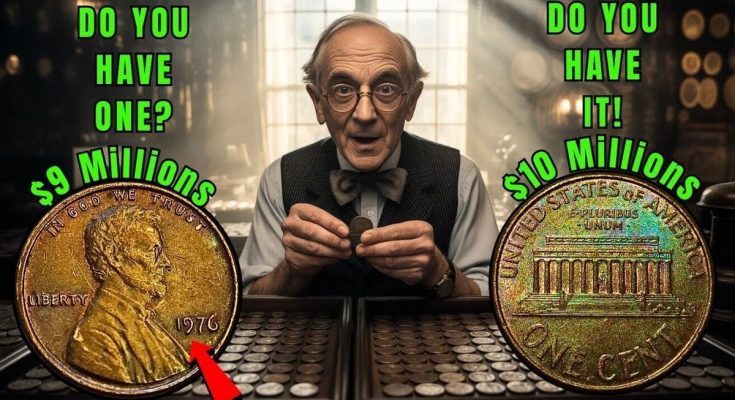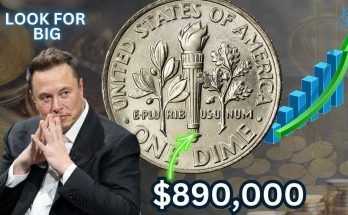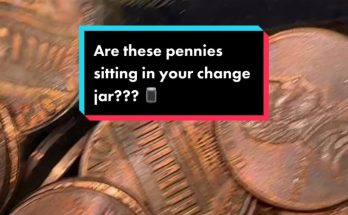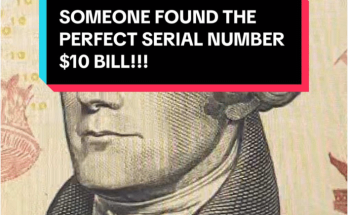Your Pocket Change Could Be a Million-Dollar Treasure!
(DO YOU HAVE THESE VERY EXPENSIVE PENNIES THAT COULD MAKE YOU A MILLIONAIRE!)
It might sound like a fantasy, a daydream you indulge in while waiting for your morning coffee, but the truth is: your pocket change, that overlooked handful of copper, zinc, and nickel, could be hiding an astronomically valuable penny. Forget the lottery; the real treasure hunt is happening in old jars, dusty coin collections, and the deepest corners of your wallet. A single, humble, one-cent coin—a mere penny—has the power to transform your life and make you a millionaire.
This isn’t just hype. It’s numismatic fact. Throughout history, due to rare errors, changes in metal composition, and extremely low mintages, a few U.S. pennies became legendary. They are the “Holy Grails” of coin collecting, and they command prices that can easily push into the six and even seven figures at auction.
The Penny That Shouldn’t Exist: The 1943 Copper Cent
If you’re going to check for one coin, this is the one. The 1943 Lincoln Cent is arguably the most famous and valuable error coin in American history, and for good reason. During World War II, copper was desperately needed for the war effort. To conserve the metal, the U.S. Mint famously switched the penny’s composition from copper to zinc-coated steel for the entire year of 1943.
This makes the 1943 steel pennies common, but the copper ones? They are an error that resulted from a few leftover copper planchets (the blank discs used to strike the coins) accidentally being fed into the presses.
- What to Look For: A penny dated 1943 that is brown/copper-colored, not the dull gray of the standard steel cent. You can even use a magnet—if a 1943 penny is attracted to a magnet, it’s the common, low-value steel version. If it doesn’t stick, you might have a copper treasure!
- The Million-Dollar Value: Fewer than 20 of the 1943 copper cents are known to exist across all mints. The single known 1943-D (Denver mint) Bronze Cent once sold for an astonishing $1.7 million. Even circulated examples from the Philadelphia or San Francisco mints can sell for hundreds of thousands of dollars.
Other Rarity Legends You Need to Know
While the 1943 copper cent is the king, it’s not the only copper coin with a hidden fortune. Several other pennies, marked by distinct errors or historical rarity, are worth a life-changing amount of money.
1. The 1944 Steel Cent
This is the inverse of the 1943 error. In 1944, the Mint switched back to the copper alloy, but a few leftover steel planchets from 1943 were mistakenly struck with the 1944 dies. A regular 1944 penny is copper-colored. If you find a steel-gray 1944 cent, you have an ultra-rare error. A 1944-S steel cent sold for over $400,000 at auction.
2. The 1909-S VDB Lincoln Cent
This coin is a collector favorite that has been valuable for over a century. It was the first year of the Lincoln Cent design, and it includes the prominent initials of the designer, V.D.B. (Victor David Brenner), on the reverse bottom. Public outcry over the prominent initials led to their removal shortly after release, making the initial mintage small. The San Francisco mint version (1909-S VDB) is the rarest of this already scarce coin, with high-grade examples selling for over $100,000 and uncirculated specimens fetching well over a million dollars.
3. The 1955 Doubled Die Obverse
This is a famous “error” coin where a misalignment of the coining die caused a striking double image. If you look closely at the date and the motto “IN GOD WE TRUST” on the coin’s front (obverse), the letters will appear distinctly doubled. This is a very popular and dramatic error, with high-quality pieces regularly trading for tens of thousands of dollars—and sometimes much more.
Your Next Steps: From Change Jar to Fortune
So, the question remains: Do you have one of these incredibly valuable pennies?
The next time you empty your change jar, take a moment to look. Even a heavily circulated version of one of these key-date or error coins is worth a small fortune.
- Check the Date: Start with the 1943 and 1944 pennies.
- Check the Metal: A 1943 copper or a 1944 steel is a major find.
- Check the Design: Look for the “V.D.B.” initials on a 1909-S and for the dramatic doubling on a 1955 date.
If you believe you’ve found one, do not clean it! Cleaning a coin can drastically reduce its value. Instead, put it in a protective holder and contact a professional coin grading service or a reputable numismatic dealer. You might just be a few cents away from a life-changing windfall!



